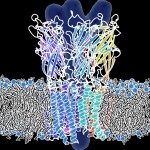Lien vers Pubmed [PMID] – 30597916
Lien vers HAL – Cliquez ici
Lien DOI – 10.3390/molecules24010104
Molecules 2018 Dec;24(1)
Residues in proteins that are in close spatial proximity are more prone to covariate as their interactions are likely to be preserved due to structural and evolutionary constraints. If we can detect and quantify such covariation, physical contacts may then be predicted in the structure of a protein solely from the sequences that decorate it. To carry out such predictions, and following the work of others, we have implemented a multivariate Gaussian model to analyze correlation in multiple sequence alignments. We have explored and tested several numerical encodings of amino acids within this model. We have shown that 1D encodings based on amino acid biochemical and biophysical properties, as well as higher dimensional encodings computed from the principal components of experimentally derived mutation/substitution matrices, do not perform as well as a simple twenty dimensional encoding with each amino acid represented with a vector of one along its own dimension and zero elsewhere. The optimum obtained from representations based on substitution matrices is reached by using 10 to 12 principal components; the corresponding performance is less than the performance obtained with the 20-dimensional binary encoding. We highlight also the importance of the prior when constructing the multivariate Gaussian model of a multiple sequence alignment.


